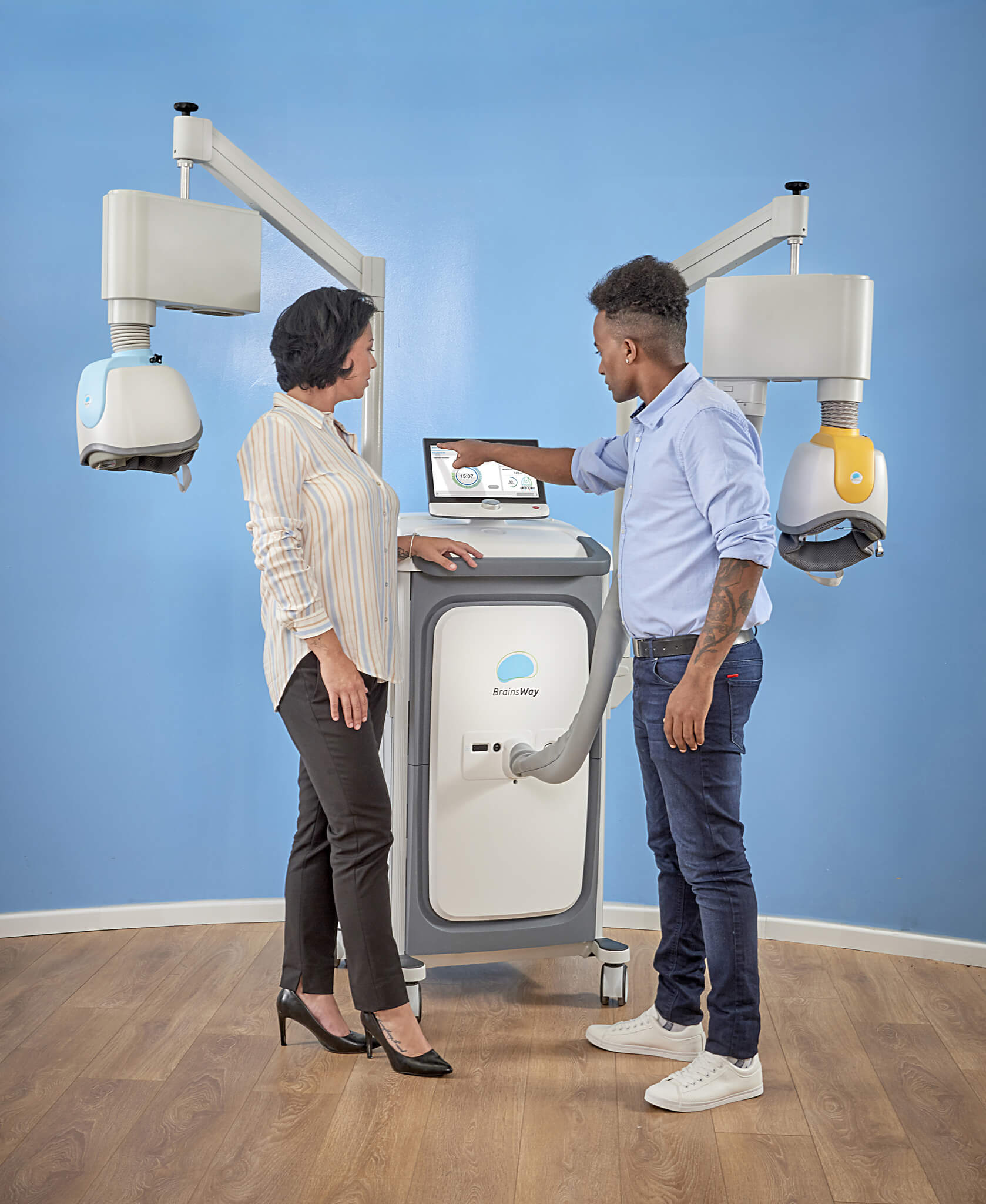TMS Therapy
Get Long-Lasting Relief with TMS at Pacific Medical Care

What Is TMS (Transcranial Magnetic Stimulation) by BrainsWay?
Deep TMS Stimulation Treatment — How It Works
Standard and deep TMS both use magnetic pulses to activate nerves. However, BrainsWay’s deep TMS system uses the H-coil to penetrate deeper areas of the brain. The areas deep in the brain contain the reward system that is associated with brain disorders, such as depression and addiction.
Previously, providers could only stimulate these areas of the brain indirectly. Now, with deep TMS, providers can directly stimulate the reward system. Also, the H-coil allows providers to target larger areas of the brain at once. Since everyone’s brains are different, providers do not have to worry about missing networks with the H-coil.
During treatment, BrainsWay’s system sends pulses of energy to the targeted areas. While a single pulse would create a short-term change, repeated pulses change the activity and connectivity of the network.

What to Expect with a Deep TMS Treatment
What to Expect During the Treatment
You will be led to a private room at Pacific Medical Care, where you will sit in a comfortable chair. Your doctor will discuss the procedure with you and provide you with earplugs. Then, the doctor will fit a cushioned helmet over your head. The skilled provider will align the helmet so it stimulates the areas that have been designated for treatment.
Then, the doctor will turn on the machine and the treatment will begin. The H-coil will send the pulses of energy into your brain’s neural networks. The energy will stimulate the cells and foster new connections.
During this process, you might experience:
- Mild Discomfort at the Treatment Site (Normally Only During the First Session)
- Muscle Twitching
- Slight Jaw Discomfort
- Tapping Sounds and Sensations
The entire process takes about 20 minutes. You will need multiple sessions to achieve the desired results. Each case is different, but you can expect to undergo sessions each day for a minimum of four weeks.
What to Expect Immediately After Treatment
Many people don’t have any side effects following treatments. Those who do find them much more tolerable than the side effects of prescription medications. People who experience side effects can expect them to go away within the first week.
Side effects might include:
- Mild Discomfort on the Skull
- Headaches
Results from Treatment Most people don’t experience results immediately after the first treatment. It can take a few weeks to see the results, but they are profound. If you are depressed, you might notice you feel more vibrant and alive than you have in years. If you are addicted, you should notice that you no longer crave substances. Your doctor might recommend maintenance sessions so you can maintain these life-changing results.

How Does TMS Therapy Help with Addiction Recovery?
Assume you were to get an MRI scan. Then, your doctor performed a second scan, this time while showing you pictures of your substance of choice.
Your doctor could look at those scans and see your reaction to the drug. Your brain would essentially light up in specific areas when looking at the pictures. This is a sign that your reward system is damaged. The system needs stimulation from your drug of choice to give you a boost of endorphins.
TMS targets the part of your brain that lights up when it’s exposed to drugs or alcohol. By stimulating the cells and neural pathways, TMS changes the way you think about drugs and alcohol. Suddenly, you won’t feel those same cravings because the idea of drugs and alcohol won’t cause your brain to light up. When drugs and alcohol no longer hijack your reward system, you can begin moving toward actual recovery.
This has proven effective for various addictions, including:
- Cigarettes
- Alcohol
- Drug Substances
Scientific research shows that your brain plays a huge role in addiction. If you can change the way your brain responds to drugs and alcohol, you can finally break free of addiction.
How Does TMS Help with Depression and Mood?
TMS works for depression and mood much in the same way it does for addiction recovery. The doctor targets the areas of the brain that are responsible for the mood disorder. By creating new pathways, people feel a boost in mood. Many completely recover from depression.
This treatment:
- Works for people who have not seen benefits from medication.
- Is even more effective when combined with cognitive-behavioral therapy.
- Is much more tolerable than medication.
Scientific research shows that your brain plays a huge role in addiction. If you can change the way your brain responds to drugs and alcohol, you can finally break free of addiction.

How Does TMS Help with Depression and Mood?
If you are suffering from addiction or depression, you feel like your life is upside down. It seems like no matter what you do, you cannot get out of the hole you’re in. You’ve tried to turn your life around, but nothing seems to work.
Pacific Medical Care is pleased to announce that we are now offering TMS treatment by BrainsWay. This is deep TMS treatment, meaning we can provide direct electromagnetic stimulation to the targeted areas of the brain. Our treatments are shorter than standard TMS treatments and more effective.
TMS could be the solution to your problems. Contact us today to learn more about getting deep TMS at Pacific Medical Care.

